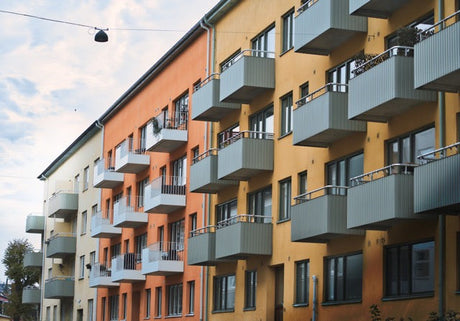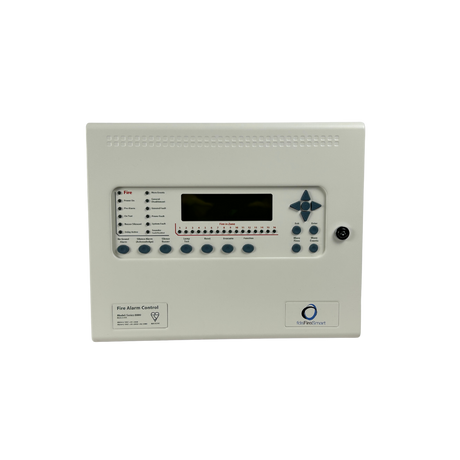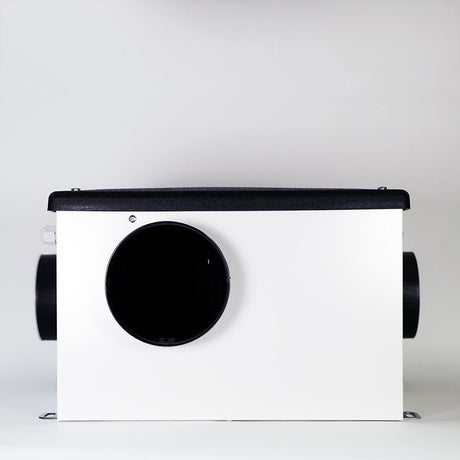In the event of a fire, smoke, not flames, is often the greatest threat to life. That’s where Automatic Opening Vent (AOV) systems come in. These smart smoke ventilation solutions automatically open windows, louvres, or roof vents to clear smoke, protect escape routes, and improve conditions for emergency responders. By using natural airflow, they create a “chimney effect” that pulls smoke upwards and out, providing vital visibility for evacuation and firefighting.
In high-rise buildings and complex structures, AOV systems aren’t just a smart feature—they're a legal and life-saving necessity.
How Do AOV Smoke Ventilation Systems Work?
A typical AOV system includes smoke/heat detectors, a compliant control panel, and motorised vent actuators. Under normal conditions, vents (in stairwells, external walls or roofs) remain closed for security and insulation. On fire alarm activation, the sequence works as follows:
|
Step 1 |
Fire/Smoke Detection |
Smoke or heat detectors (or a manual break-glass call point) send a signal to the fire alarm control panel. |
|
Step 2 |
Control Panel Response |
A compliant control panel triggers the AOV system. The panel sends commands to the appropriate vent actuators (for example, a stairwell skylight, smoke lobby damper or louvered vent) corresponding to the fire |
|
Step 3 |
Vent Opening |
Actuators drive vents to their fully “fire-open” position (usually within 60 seconds), powered by 24 V DC with battery backup. Cooler outside air is drawn in at low level as hot smoke escapes upwards, rapidly clearing stairwells and corridors. |
|
Step 4 |
Smoke Extraction Continues |
The natural airflow (or mechanical fans in hybrid systems) continues to extract smoke until the system is reset. This keeps key escape paths smoke-free, delays flashover and reduces heat build-up, buying vital time for evacuation and firefighting. |
AOV systems may also include manual overrides (firefighter switches and break-glass units) to allow controlled venting if needed. All components (vents, actuators, panels, detectors and wiring) are usually powered by low-voltage 24 V DC supplies for safety, with rechargeable batteries so the system operates even during a power cut.
Key Components of an AOV System
- Smoke Vents and Windows: Louvre vents, rooflights or dedicated smoke shafts that open automatically to release smoke. These are positioned high in stairwells, corridors, atriums or shaft heads.
- Actuators: Electric opening devices (chains, linear arms or folding arms) attached to windows or vents. Certified actuators must be matched to suitable vent profiles to meet BS EN 12101-2 performance requirements.
- Control Panel: A fire alarm or dedicated smoke-control panel (usually BS 5839-compliant) that processes detector signals and triggers the actuators. Panels can be single-zone (controlling one or two vents) or multi-zone for larger buildings.
- Smoke/Heat Detectors: Conventional detectors in corridors and lobbies that sense fire conditions and activate the system.
- Power Supply: 24 V DC power units with automatic battery backup, ensuring AOV operation even if mains power fails.
-
Fireman’s Switches: Manual override switches (often called fireman’s switches) that allow firefighters to open vents in an emergency.
- Integration: The AOV panel is typically linked into the building’s fire alarm system so that any alarm can trigger the vents automatically.
All components must be compatible and installed to the correct standards—especially BS EN 12101-2, which certifies complete vent-and-actuator assemblies under fire conditions.
Meeting UK Fire Safety Regulations
Installing an AOV system isn’t just best practice—it’s a legal requirement for many buildings. Key regulations include:
Approved Document B (ADB)
Under UK Building Regulations, multi-storey residential buildings (typically 11 m+ in height) must include smoke ventilation. This usually means:
- 1.0 m² free vent area for stairwells.
- 1.5 m² free vent area for corridors/lobbies.
- Vents are placed high above doors or stairs.
-
Automatic operation on fire detection, with manual override for firefighters.
BS 9991 (Residential) & BS 9999 (Commercial)
These British Standards offer design guidance for smoke control in residential and commercial buildings. BS 9991 (2024) clarifies where natural or mechanical systems are appropriate and includes stricter rules for preventing smoke crossover between zones.
BS EN 12101-2
All AOV systems must be CE or UKCA marked under this standard. It ensures the entire vent/actuator assembly:
- Opens under smoke and heat loads.
- Resists weather and fire.
- Functions on battery power.
Manufacturers must supply a Declaration of Performance and a certificate of conformity.
Fire Safety Act 2021 & Building Safety Act 2022
Building owners (the “responsible persons”) must ensure that fire safety systems, including AOVs, are:
- Properly maintained and tested.
- Documented as part of the building’s “golden thread” of safety information.
Neglecting this can result in enforcement action and legal penalties.
Selecting and Installing AOV Systems
When planning an AOV system, consider:
- Certified Products: Always use independently tested, BS EN 12101-2 certified vent and actuator assemblies. Check that each vent unit has a Declaration of Performance and third-party certificate. CE/UKCA marking is not optional. Certified systems (often accredited under schemes like SCA/IFC SDI-19) ensure the equipment will perform as intended.
- Appropriate Sizing: Calculate the required free vent area per floor and per shaft, as per ADB guidance. A vent with only 0.5 m² free area will not suffice in most cases; 1.0 m² for stair exits and 1.5 m² for corridors are the rule of thumb. Also consider total vent area per zone if using multiple vents.
- Compatible Components: The control panel, detectors and actuators must be compatible. All electrical parts should be low-voltage (24 V DC) and comply with BS EN 12101-2. Avoid mixing brands if untested together. Ensure a suitable battery backup is specified (typically 24 V, with 1–2 hour autonomy).
- Professional Installation: AOV systems should be installed and commissioned by qualified smoke-control contractors. UK guidance and law require fire-safety systems to be installed by “competent persons” (often demonstrated by accreditation from BAFE or SCA/IFC SDI-19). Proper commissioning includes smoke tests and documentation. Installers must integrate the AOV with the fire alarm panel so vents open automatically on any fire signal.
- Routine Maintenance: After installation, schedule regular servicing. Industry best practice is at least annual (some recommend biannual) checks of vents, actuators and controls. Maintenance logs should be kept, as required under the Fire Safety Order. This keeps the system reliable and maintains compliance; a failed AOV in an emergency could be a serious offence under fire safety law.
Where are AOV Systems Used?
Wherever people gather in multi-storey buildings, AOV systems play a critical role in life safety. AOVs are widely installed in:
- Residential Apartments/Flats: In multi-storey residential buildings, AOV vents are often installed in stair cores, lobbies or smoke shafts. Approved Document B usually requires each stair to have an opening vent (or smoke shaft) with at least 1.0–1.5 m² free area to keep stairways clear. This provides a protected evacuation route for residents and simplifies fire service access.
- Commercial Offices and Public Buildings: Office blocks, hotels, and complexes with atria use AOV rooflights and vents over stairs and lobbies. These exhaust smoke during fires, preserving the building structure and safety. In large open-plan spaces or atria, mechanically-assisted vents may be combined with AOVs. Many non-domestic buildings (schools, hospitals, theatres, etc.) install AOVs in corridors and roofs as part of their overall smoke-control strategy.
- Car Parks and Underground Spaces: Enclosed parking garages and underground facilities often rely on natural smoke vents (roof hatches) alongside powered fans. AOV roof vents or shafts open automatically to clear vehicle exhaust and fire smoke, protecting people and firefighters. These systems are designed per BS 7346-8 and usually include extraction fans, but many still classify as “AOV” if vents open on fire detection.
- Other Buildings: Any large building with internal stairs or atria, such as student residences, hospitals, shopping centres or sports arenas, may use AOVs. Early smoke extraction prevents smoke spreading through escape routes and reduces heat. In high-rise buildings, multiple AOVs (including on high-level stairhead penthouses) give smoke a route out of the building, rather than allowing it to fill stairwells.
Why Certified AOV Systems Matter
Fire safety isn’t the place to cut corners. Cheap or uncertified AOV products can fail when it matters most. Ensure:
- Every vent and actuator is CE/UKCA marked to BS EN 12101-2.
- The system is commissioned by qualified fire safety professionals.
-
Ongoing maintenance is documented and scheduled.
This is more than box-ticking—it’s about saving lives. In a fire, the reliability of your AOV system may be the difference between safe evacuation and catastrophe.
Smoke Venting Solutions at Inbuild
At Inbuild, we provide fully compliant, high-performance smoke ventilation solutions tailored to the needs of modern residential and commercial buildings. Our range of AOV systems—including roof vents, wall-mounted louvres, and smoke shaft solutions—are tested and certified to BS EN 12101-2 standards, ensuring they meet the highest safety and regulatory requirements.
Whether you're designing a new development or upgrading an existing fire strategy, our team offers expert guidance, specification support, and access to trusted products. With Inbuild, you can be confident your building is protected by reliable, regulation-ready smoke venting systems designed to save lives.





